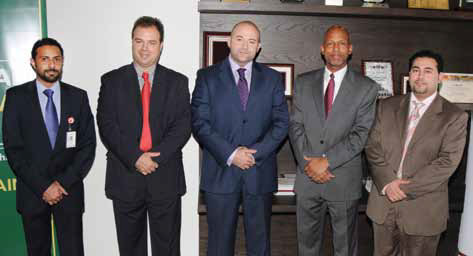4
ePartner
Interview with Mr. David Bullock, CEO & Co-Founder, CEO Mastery, Inc

David Bullock (Profit Engineer) is the CEO and Cofounder of CEO Mastery - an executive training and business development firm. He is also the coauthor of Barack Obama’s Social Media Lessons for Business. David has a degree in mechanical engineering from the University of Delaware and started his career with engineering positions at Mobil Oil and the DuPont Company, as well as Fanuc Robotics North America. He has held positions as Chief Media Officer at The Nurse Company, Inc and Chief Marketing Officer at Social Media Connection.
David Bullock was recently in the region to conduct several seminars and talks about the successful use of social media for both government and business development. His talks were based on his experience while tracking the 2008 United States Presidential Campaign where a hopeful young Senator (Barack Obama) masterfully utilized social media platforms to best his opponents and attain the position of President of The United States.
 What are the key online services provided by the Customs Affairs?
What are the key online services provided by the Customs Affairs?
The Strategic Narrative: “Embracing Technology As A Participating Leader”. The eGovernment has the opportunity to lead the charge by sponsoring training that demonstrates the effective utilization of the social media platforms for business. Since business touches every aspect of the consumer markets, training the business sector will provide the most leverage and reach for the eGovernment Authority. The very people that the eGovernment is looking to connect with are patrons of the businesses within the region. Only the eGovernment has the infrastructure to initiate and execute a directive of this magnitude. In terms of scale, the key is to start with a small initiative, monitor the results and then roll the campaign out to the masses. Using social media platforms does not mean that the campaign has to run in an unmanaged fashion. The proper monitoring technologies can and should be employed to ensure the success of any campaign.
Bear in mind that social media started as consumer-driven media. But, once understood, business and government have a tremendous opportunity to leverage these media channels to engage and communicate with the already active social media community.
When we lived in a one-way communication paradigm, it was enough to just monitor communication. Now that we are in a two-way communication environment, participation is critical.
The eGovernment Authority is ready. It is a matter of coordination between departments, content generation and systematic deployment.
The ultimate goal is to get the audience to visit the organization’s website or blog, and most importantly, take a specific engagement action on the website.
 Is it wise for an organization to have accounts or presence in all social media spaces?
Is it wise for an organization to have accounts or presence in all social media spaces?
There are over 1,600 “Social Media” spaces available. Depending on your deployment goals all 1,600 can prove to be valuable. But the typical organization should concentrate on the big 4: Facebook, Google+, Twitter and LinkedIn. The ultimate goal is not only to interact within these social media platforms, it is to get the audience to visit the organization’s website or blog, and most importantly, take a specific engagement action on the website. An action such as leaving a comment or filling out a form is more valuable than any action taken within a social media platform. Once the understanding is in place that social media platforms start and contain conversations that ultimately lead to an action on the organization’s website, then the platform that is used becomes a question around where the target audience is congregating.
 Marketing and PR effort is all about communications and relations. What is the added value of social media presence?
Marketing and PR effort is all about communications and relations. What is the added value of social media presence?
The value is instant two-way communication in a multimedia format. Typical marketing and PR efforts are one-way communications and primarily engaged to get attention and create awareness to a desired action. Social media has the advantage of trusted friends with common interest and meeting place. The inherent trust fostered through the peer-to-peer communication within a social media setting is not achieved through typical marketing and PR efforts. Thus, the “trust factor” of friends sharing with friends is built into the media channel itself.

 When creating social content, organizations wait for positive outcome, but negative content posted online is probable. What is the balance of this equation?
When creating social content, organizations wait for positive outcome, but negative content posted online is probable. What is the balance of this equation?
There is a very old saying… You cannot satisfy everyone. People, if given a platform, will take the opportunity to place negative comments about an organization no matter how good the intentions of the organization. It is the organization’s responsibility to monitor and respond publically to negative comments that show up in “Social Media”. Those comments, if valid, are actually feedback from the marketplace. To address them properly within the business practice is step one. To address the negative feedback publically demonstrates to the marketplace that the organization is truly paying attention and actually cares about the customers’ experience. Welcome the “feedback” and make adjustments accordingly.
 How can corporate social media marketing efforts best be coordinated to achieve business outcomes?
How can corporate social media marketing efforts best be coordinated to achieve business outcomes?
Analytics is key to achieve business outcomes. Knowing how much traffic comes to the website is only one of the many factors that define the website’s overall success.
Other factors are:
- Time spent on site
- Other pages navigated
- Number of downloads
- Number of emails collected
- Number of specifically designed actions taken
The list above only scratches the surface. The coordination of social media marketing for business starts with defining the critical success factors of the campaign. Then design the social media campaign in such a way that the predefined success factors can be easily measured as milestones toward an ultimate goal. The primary operative question is “What do I want the visitor to do after they encounter the content?”
Content in this case is audio, video or text. Once the ultimate desired action of the visitor is determined, the rest of the process can be designed.

 Given the resources necessary to support social media marketing initiatives, is the return or success always measurable?
Given the resources necessary to support social media marketing initiatives, is the return or success always measurable?
Yes, at least it should be. And, if a campaign is not successful, the data will be available to determine what happened in the campaign and what adjustments are required to attain a positive ROI. There are tracking and analytics tools available now that leave no question unanswered.
 What golden advice do you have for public entities using or opting to use social media outlets?
What golden advice do you have for public entities using or opting to use social media outlets?
Know that this is a technology that is vast and fast. This means any public entity can touch 100,000 with the push of a button. This level of power is invaluable. But, be aware it is also a double-edged sword. The same marketplace that is being communicated to has the same ability to communicate to those same 100,000 people with a push of the button.
Know that social media is a two-way communication channel that requires active participation from the organization in both speaking to the marketplace and listening to the response. The speaking must be strategic and well planned. And, the listening must be diligent. This media requires knowledge and experience as the social media channel is dynamic in nature.
Use the media for its direct connection to the individuals that influence your brand and public persona. And in the long run, the organization must define the brand or the marketplace will define it for them. So get the training, invest in the tools and take the lead.